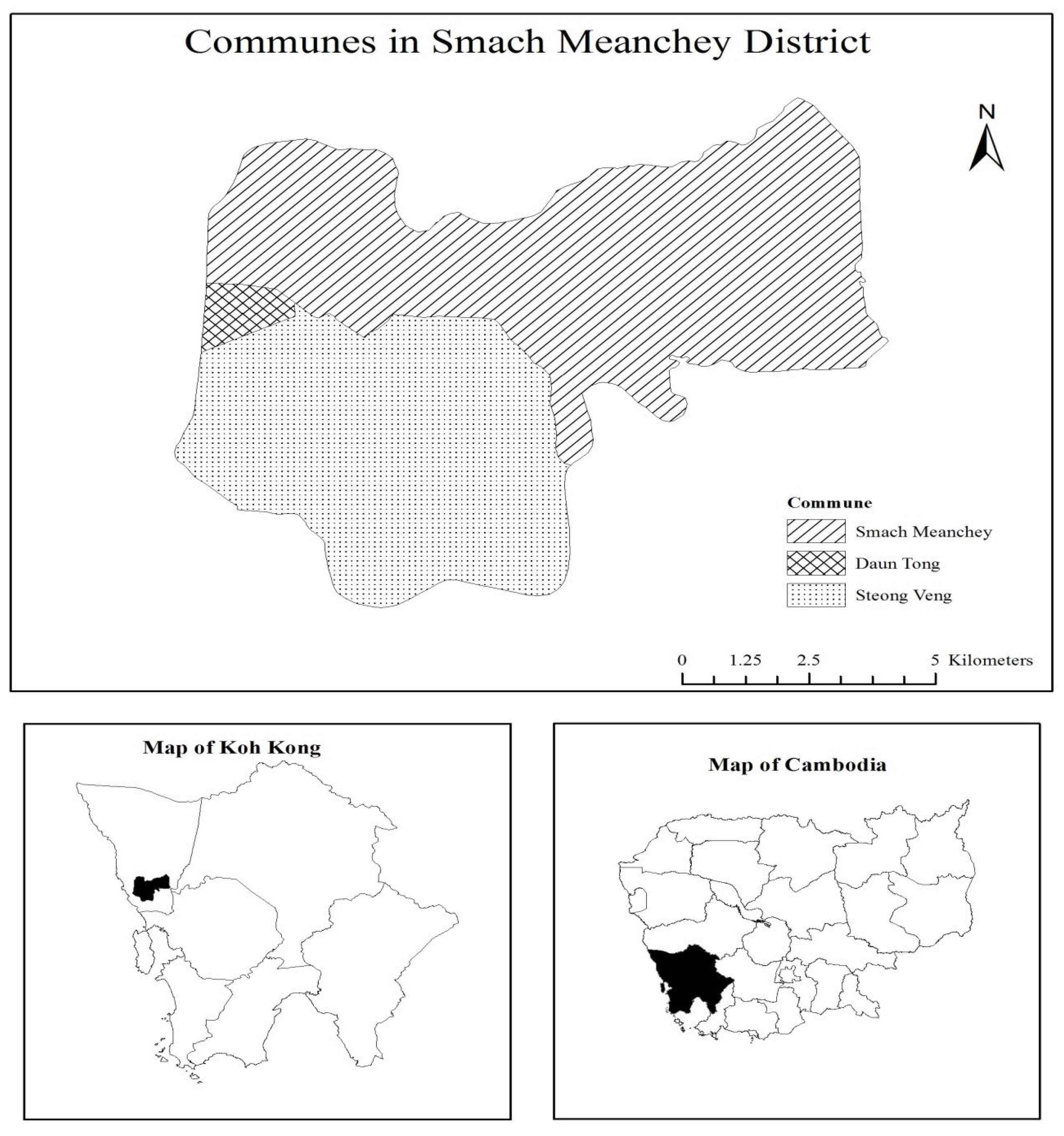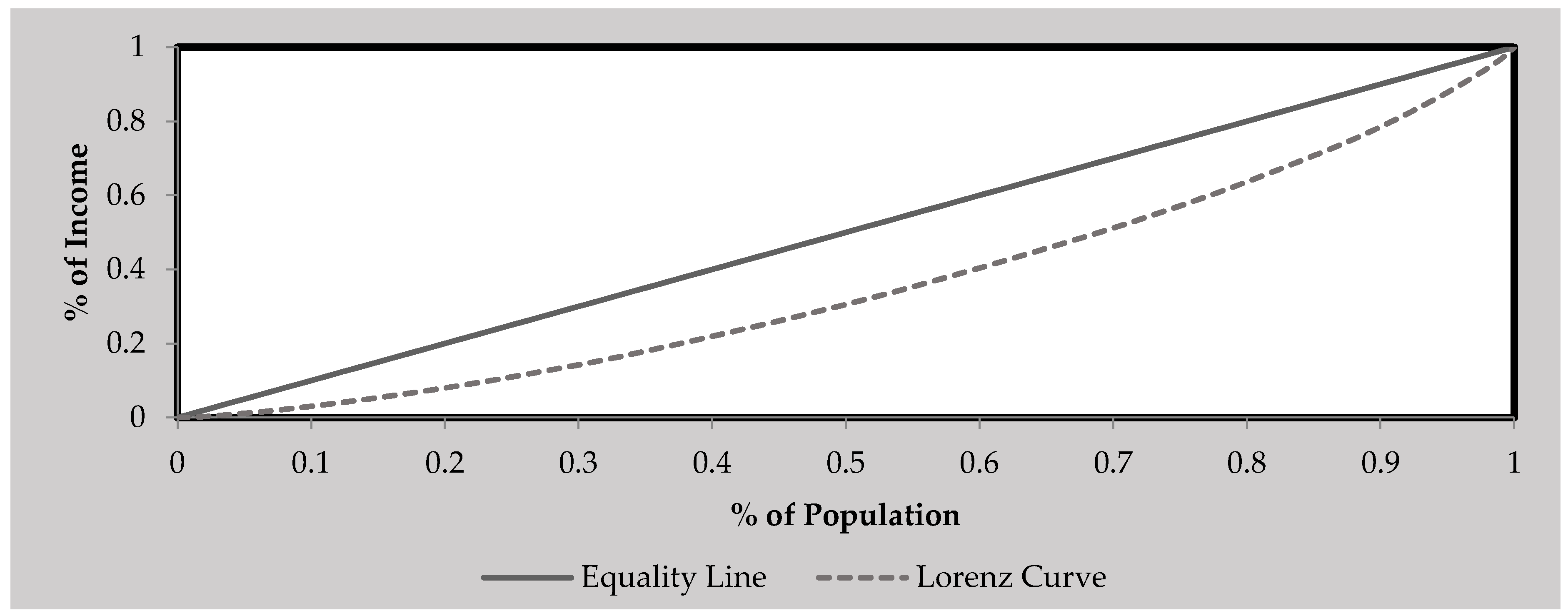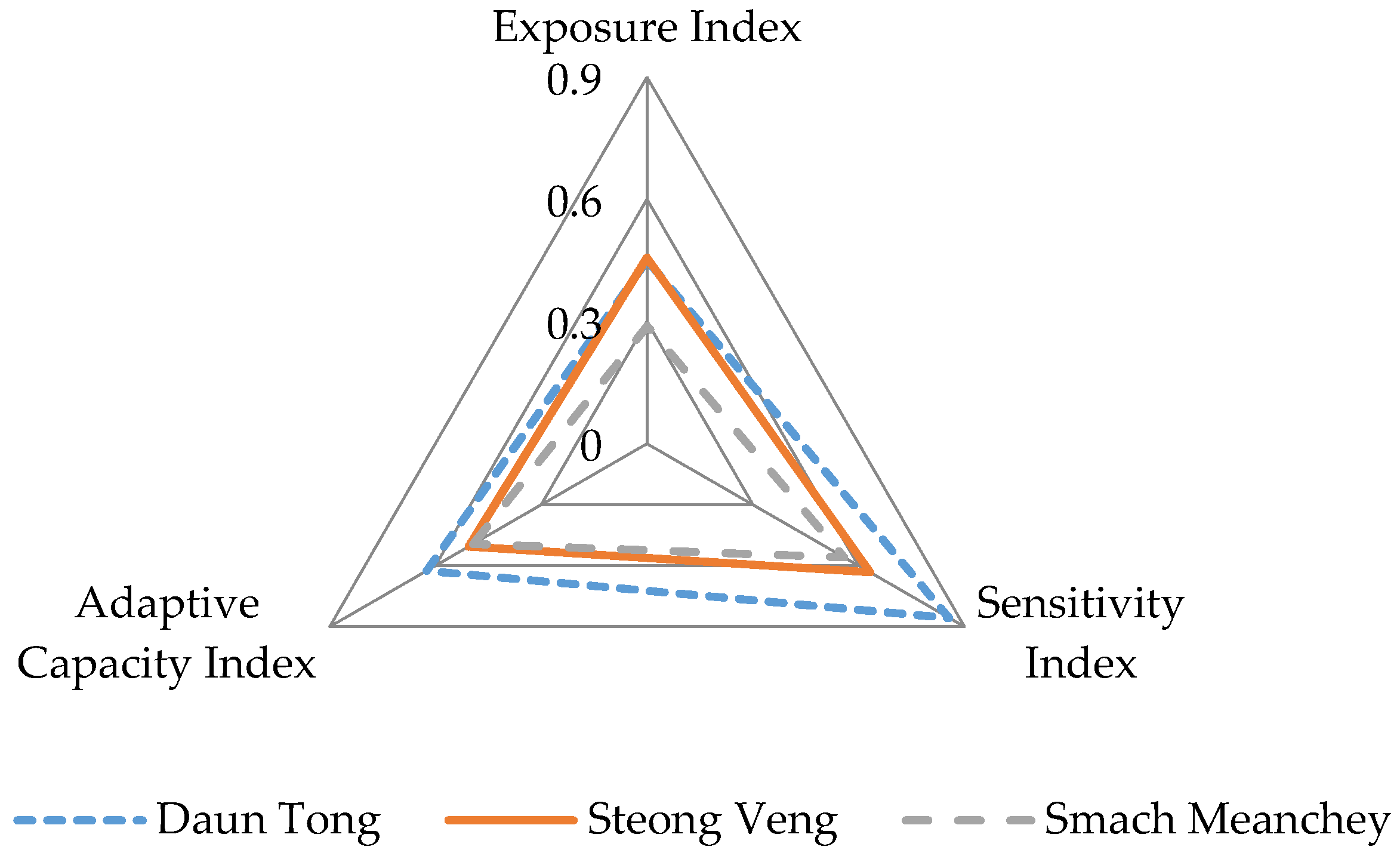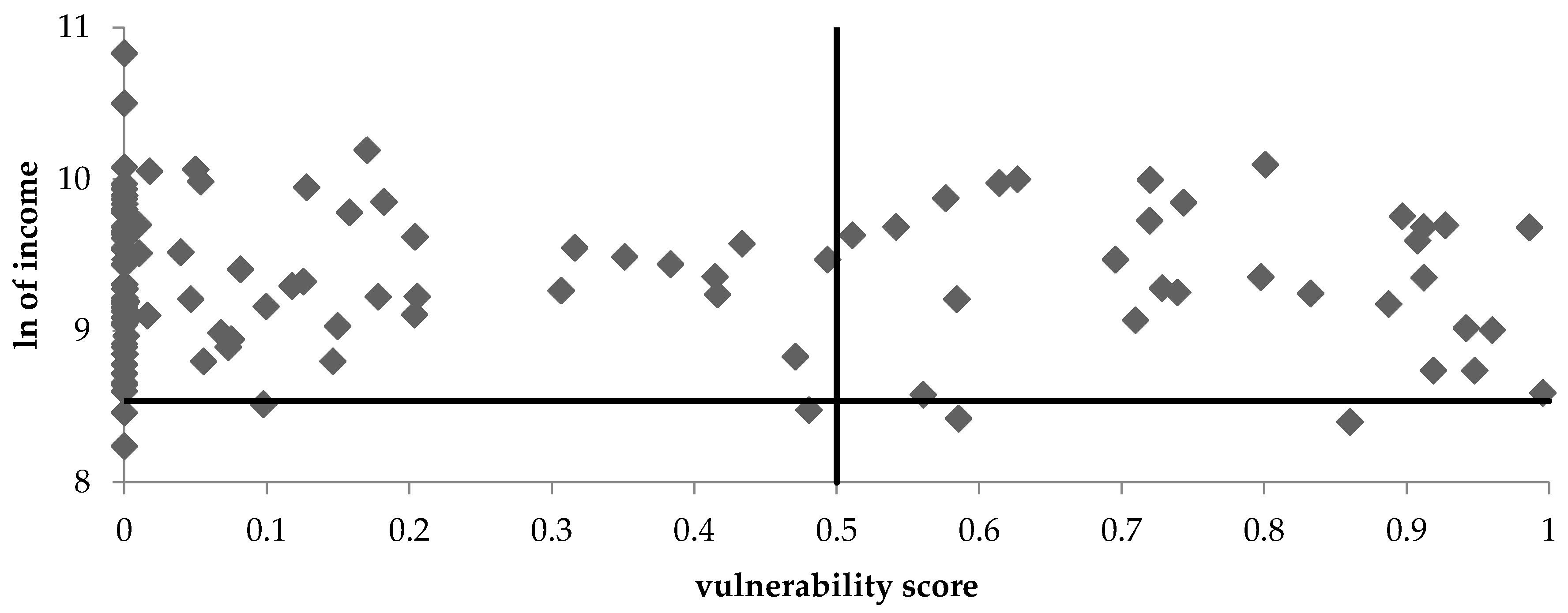Urban Climate Vulnerability in Cambodia: A Case Study in Koh Kong Province
Abstract
:1. Introduction
- To identify the most vulnerable region of climate hazards through the construction of an index to compare three different communes in Koh Kong.
- To measure the vulnerability to poverty in urban locations through the comparison of poor and non-poor households.
2. Methodology
2.1. Study Area
2.2. Sampling Methodology
2.3. Vulnerability Index
2.4. Vulnerability as Expected Poverty
3. Results
3.1. Household Characteristics
3.2. Gini Coefficient and Inequality
3.3. Climate Vulnerability
3.3.1. Exposure Index
3.3.2. Sensitivity Index
3.3.3. Adaptive Capacity Index
3.3.4. Vulnerability Index
3.4. Poverty and Vulnerability
4. Discussion
Determinants of Vulnerability to Poverty
5. Conclusions
6. Further Study
Acknowledgments
Conflicts of Interest
Appendix A
| Exposure Indicators | Descriptive | Type of Measurement | Expected Sign |
|---|---|---|---|
| Flood | The number of floods affecting households that occurred during the last 5 years | Scale | + |
| Impact of flooding on livelihood | Ordinal | + | |
| Drought | Period of insufficient clean water usage per year during the last 5 years | Scale | + |
| Impact of drought on livelihood | Ordinal | + | |
| Typhoon | Frequency of typhoons affecting household livelihood per year during the last 5 years | Scale | + |
| Impact of typhoons on livelihood | Ordinal | + | |
| Storm | Frequency of storms affecting household livelihood per year during the last 5 years | Scale | + |
| Impact of storms on livelihood | Ordinal | + |
| Descriptive | Type of Measurement | Expected Sign |
|---|---|---|
| Damage to property and livestock due to climate hazards | Ordinal | + |
| Number of family member(s) injured due to floods, storms, and landslides | Scale | + |
| The level of household dependency on natural resources | Ordinal | + |
| Agricultural dependency for income | Ordinal | + |
| Road conditions after flooding | ordinal | − |
| Distance from market (minutes of traveling) | Scale | + |
| Lacking clean water during drought | Ordinal | + |
| Accessibility to healthcare (level of receiving health services per year) | Ordinal | + |
| Descriptive | Unit of Measurement | Expected Sign |
|---|---|---|
| Housing quality | Ordinal | + |
| Tools and technology to access climate information (TV, radio, mobile phone) | Ordinal | + |
| Self-protection tools such as sandbags, life-jackets, and so on | Scale | + |
| Number of family members who finished grade 9 | Scale | + |
| Number of family members who earn income | Scale | + |
| Training or vocational course related to climate change attended by family members | Scale | + |
| Assistance from government | Ordinal | + |
| Availability of supportive policy | Ordinal | + |
| Diversification of income sources | Scale | + |
| Rice reserve during a shock | Ordinal | + |
| Ownership (animal, livestock) | Ordinal | + |
| Amount of borrowing from formal and informal sectors (debt: monthly) | Scale | + |
| Information sharing related to climate hazards with neighboring | Ordinal | + |
| Amount of social support from relatives and community during and after disaster | Ordinal | + |
| Dependency ratio | Ordinal | + |
| Descriptive of Independent Variables | Unit of Measurement | Expected Sign |
|---|---|---|
| Age of respondent | Scale (years) | − |
| Household sizes | Scale (persons) | + |
| Education of the head of household | Scale (years) | − |
| Climate hazards (exposure index) | Scale (Index) | + |
| Agricultural dependency | Ordinal (rating) | + |
| Level of healthcare accessibility | Ordinal (rating) | − |
| Housing quality | Ordinal (rating) | − |
| Assistance from government during a shock | Dummy (0.1) | − |
| Income diversification | Dummy (0.1) | − |
| Possession of livestock asset | Dummy (0.1) | + |
| Debt accessibility | Dummy (0.1) | − |
| Access to information related to climate hazards | Ordinal (rating) | − |
References
- Amemiya, Takeshi. 1977. The maximum likelihood and the nonlinear three-stage least squares estimator in the general nonlinear simultaneous equation model. Econometrica: Journal of the Econometric Society 45: 955–68. [Google Scholar] [CrossRef]
- Andersen, Lykke E., and Marcelo Cardona. 2013. Building Resilence against Adverse Shocks: What Are the Determinants of Vulnerability and Resilence? Development Research Working Paper Series No. 02/2013. La Paz, Bolivia: Institute for Advanced Development Studies. [Google Scholar]
- Chaudhuri, Shubham, Jyotsna Jalan, and Asep Suryahadi. 2002. Assessing Household Vulnerability to Poverty from Cross-Sectional Data: A Methodology and Estimates from Indonesia. Discussion Paper, No. 0102-52. New York, NY, USA: Columbia University. [Google Scholar]
- Chen, Wenfang, Susan L. Cutter, Christopher T. Emrich, and Peijun Shi. 2013. Measuring social vulnerability to natural hazards in the Yangtze River Delta region, China. International Journal of Disaster Risk Science 4: 169–81. [Google Scholar] [CrossRef]
- Chhinh, Nyda. 2014. Climate Change Adaptation in Agriculture in Cambodia. London: Edward Elgar Publishing. [Google Scholar]
- Chhinh, Nyda, and Hoeurn Cheb. 2013. Climate Change Vulnerability: Household Assessment Levels in the Kampong Speu Province, Cambodia. In Climate Change Vulnerability Assessment in Kampong Speu Province, Cambodia. Phnom Penh: Phnom Penh Royal University of Phnom Penh, pp. 53–62. [Google Scholar]
- Climate Investment Funds (CIF). 2014. Climate Change Impact Modeling and Vulnerability Assessments for Koh Kong and Mondulkiri Provinces in Cambodia. Phnom Penh: ADB. [Google Scholar]
- Depietri, Yaellav, Torsten Welle, and Fabrice G. Renaud. 2013. Social vulnerability assessment of the Cologne urban area (Germany) to heat waves: Links to ecosystem services. International Journal of Disaster Risk Reduction 6: 98–117. [Google Scholar] [CrossRef]
- Elbers, Chris, Jean O. Lanjouw, and Peter Lanjouw. 2001. Welfare in villages and towns: Micro-level estimation of poverty and inequality. Econometrica 71: 355–64. [Google Scholar] [CrossRef]
- Gaiha, Raghav, and Katsushi Imai. 2008. Measuring Vulnerability and Poverty Estimates for Rural India. Working Paper UNU-WIDER 2008.40. Helsinki, Finland: Unitded Nation University. [Google Scholar]
- Gbetibouo, Glwadys Aymone, and Claudia Ringler. 2009. Mapping South African Farming Sector Vulnerability to Climate Change and Variability: A Subnational Assessment. IFPRI Discussion Paper. Washington, DC, USA: International Food Policy Research Institute (IFPRI), Pretoria, South Africa: Center for Environmental Economics and Policy in Africa (CEEPA). [Google Scholar]
- Gbetibouo, Glwadys A., Claudia Ringler, and Rashid Hassan. 2010. Vulnerability of the South African farming sector to climate change and variability: An indicator approach. Natural Resources Forum 34: 175–87. [Google Scholar] [CrossRef]
- Hahn, Micah B., Anne M. Riederer, and Stanley O. Foster. 2009. The Livelihood Vulnerability Index: A pragmatic approach to assessing risks from climate variability and change—A case study in Mozambique. Global Environmental Change 19: 74–88. [Google Scholar] [CrossRef]
- Hay, John, and Nobuo Mimura. 2006. Supporting climate change vulnerability and adaptation assessments in the Asia-Pacific region: An example of sustainability science. Sustainability Science 1: 23–35. [Google Scholar] [CrossRef]
- Heng, Pheakdey. 2012. Cambodia’s Energy Security Is at Risk. Available online: https://www.cambodiadaily.com (accessed on 24 October 2016).
- Irvine, Kim, Murphy Tom, M. Sampson, D. Va, Stephen J. Vermette, and Tao Tang. 2006. An overview of water quality issues in Cambodia. In Effective Modeling of Urban Water Systems, Monograph, 14. Guelph: Computational Hydraulics International. [Google Scholar]
- Kelly, Mick P., and Neil W. Adger. 2000. Theory and practice in assessing vulnerability to climate change andFacilitating adaptation. Climatic Change 47: 325–52. [Google Scholar] [CrossRef]
- Ligon, Ethan, and Laura Schechter. 2003. Measuring vulnerability. The Economic Journal 113: C95–C102. [Google Scholar] [CrossRef]
- Liu, Chunling, Dominic Golding, and Gang Gong. 2008. Farmers’ coping response to the low flows in the lower Yellow River: A case study of temporal dimensions of vulnerability. Global Environmental Change 18: 543–53. [Google Scholar] [CrossRef]
- Ludeña, Carlos E., and Sang Won Yoon. 2015. Local Vulnerability Indicators and Adaptation to Climate Change: A Survey. Washington: Inter-American Development Bank. [Google Scholar]
- McCarthy, James J., Osvaldo F. Canziani, Neil A. Leary, David J. Dokken, and Kasey S. White. 2001. Climate Change 2001: Impacts, Adaptation, and Vulnerability. Camberidge: Camberidge University Press. [Google Scholar]
- McGranahan, Gordon, Deborah Balk, and Bridget Anderson. 2007. The rising tide: assessing the risks of climate change and human settlements in low elevation coastal zones. Environment and Urbanization 19: 17–37. [Google Scholar] [CrossRef]
- Megersa, Dawit. 2015. Measuring Vulnerability to Poverty. Uppsala: SLU, Department of Economics. [Google Scholar]
- Mendoza, Maria Emilinda T., Bui Dung The, Heng Naret, Vicente G. Ballaran, and Jamie Kim B. Arias. 2014. Assessing vulnerability to climate change impacts in Cambodia, the Philippines and Vietnam: An analysis at the commune and household level. Journal of Environmental Science and Management 17: 78–91. [Google Scholar]
- Mirza, M. Monirul Qader. 2003. Climate change and extreme weather events: Can developing countries adapt? Climate Policy 3: 233–48. [Google Scholar] [CrossRef]
- MoE. 2002. Physical Framework Plan Koh Kong Province. Phnom Penh: Ministry of the Environment. [Google Scholar]
- MoE. 2013. Cambodia Climate Change Strategic Plan 2014–2023. Phnom Penh: National Climate Change Committee. [Google Scholar]
- Moser, Caroline O. N. 1998. The asset vulnerability framework: Reassessing urban poverty reduction strategies. World Development 26: 1–19. [Google Scholar] [CrossRef]
- Ncube, Mkhululi, Nomonde Madubula, Hlami Ngwenya, Nkulumo Zinyengere, Leocadia Zhou, Joseph Francis, Talentus Mthunzi, Crespo Olivier, and Tshilidzi Madzivhandila. 2016. Climate change, household vulnerability and smart agriculture: The case of two South African provinces: Original research. Jàmbá: Journal of Disaster Risk Studies 8: 1–14. [Google Scholar] [CrossRef]
- NIS. 2008. General Population Census of Cambodia 2008. Phnom Penh: National Institute of Statistics, Ministry of Planning. [Google Scholar]
- Oni, Omobowale, and Sulaiman Yusuf. 2008. Determinants of Expected Poverty among Rural Households in Nigeria. African Economic Research Consortium Resarch Paper. Nairobi, Kenya. [Google Scholar]
- Opiyo, Francis E. O., Oliver V. Wasonga, and Moses M. Nyangito. 2014. Measuring household vulnerability to climate-induced stresses in pastoral rangelands of Kenya: Implications for resilience programming. Pastoralism 4: 1–15. [Google Scholar] [CrossRef]
- Piya, Luni, Keshav Lall Maharjan, and Niraj Prakash Joshi. 2012. Vulnerability of rural households to climate change and extremes: Analysis of Chepang households in the Mid-Hills of Nepal. Paper presented at the 2012 International Association of Agricultural Economists (IAAE) Triennial Conference, Foz do Iguacu, Brazil, August 18–24. [Google Scholar]
- Satterthwaite, David, Saleemul Huq, Hannah Reid, Mark Pelling, and Patricia Romero Lankao. 2007. Adapting to Climate Change in Urban Areas: The Possibilities and Constraints in Low-and Middle-Income Nations. London: IIED, vol. 1. [Google Scholar]
- Solesbury, William. 2003. Sustainable Livelihoods: A Case Study of the Evolution of DFID Policy. London: Overseas Development Institute. [Google Scholar]
- Srinivasan, Veena, Karen C. Seto, Ruth Emerson, and Steven M. Gorelick. 2013. The impact of urbanization on water vulnerability: A coupled human–environment system approach for Chennai, India. Global Environmental Change 23: 229–39. [Google Scholar] [CrossRef]
- UNEP. 2013. Mainstreaming of Climate Change Adaptation into the Sub-National Development Planning in Cambodia. Nairobi: United Nations Environment Programme. [Google Scholar]
- UNICEF. 2010. Health Service Access among Poor Communities in Phnom Penh. New York: UNICEF. [Google Scholar]
| 1 | Ancha Srinivasan is ADB’s climate change specialist of Southeast Asia Department. |
| 2 | The study used purposing sampling based on researcher knowledge to identify the participants, so the sample may not truly represent the population due to the lack of randomness. Thus, the results of this study may not be able to represent the urban vulnerability in other regions. |
| 3 | The study used geometric mean instead of arithmetic mean. |
| 4 | As the study focused on the urban area, it was more appropriate to assume that households saved money, so income was used rather than consumption for its nature of heteroscedasticity. |
| 5 | See: Elbers, Lanjouw, and Lanjouw (Elbers et al. 2001). |
| 6 | The result was only based on a one-time observation. The lack of experimental design may not capture the true vulnerability degree across time intervals and could also influence the result. The longitudinal study could be a better alternative method for a vulnerability assessment and be more flexible for the experiment. In addition, the use of low poverty thresholds and 50% cutoff point could also influence the result as well. As the study implemented low poverty thresholds, it may not represent the vulnerability in an urban area since the living cost was higher than the urban national poverty line. The use of the 50% cutoff point to indicate the state of being vulnerable in the next period could also lead to bias; however, the benchmark level was still subjective from the author’s point of view. |





| Household Characteristics | Total | Daun Tong | Steong Veng | Smach Meanchey | ||||
|---|---|---|---|---|---|---|---|---|
| Mean | Standard Deviation | Mean | Standard Deviation | Mean | Standard Deviation | Mean | Standard Deviation | |
| Age of household head | 43.93 | 13.40 | 43.80 | 13.50 | 45.60 | 13.90 | 42.70 | 13.10 |
| Education of head of household | 4.91 | 4.00 | 4.30 | 3.60 | 4.60 | 4.10 | 5.50 | 4.20 |
| Household sizes | 5.04 | 2.14 | 5.70 | 2.10 | 5.00 | 2.40 | 4.70 | 1.90 |
| Household members who finished grade 9 | 1.07 | 1.19 | 1.50 | 1.30 | 0.70 | 1.20 | 1.00 | 1.10 |
| Household members who earn revenue | 2.13 | 1.06 | 2.40 | 1.10 | 2.10 | 1.10 | 1.90 | 1.00 |
| Monthly household income (dollars) | 463.93 | 244.47 | 518.39 | 183.78 | 443.83 | 263.71 | 442.85 | 263.12 |
| Monthly household consumption (dollars) | 387.55 | 176.53 | 453.03 | 153.10 | 356.96 | 171.27 | 367.02 | 186.53 |
| Daily income per person (dollars) | 3.28 | 1.68 | 3.37 | 1.64 | 3.12 | 1.38 | 3.32 | 1.92 |
| Daily consumption per person (dollars) | 2.75 | 1.15 | 2.90 | 1.22 | 2.60 | 1.16 | 2.71 | 1.09 |
| Descriptive | Component Score Coefficient | Daun Tong | Steong Veng | Smach Meanchey |
|---|---|---|---|---|
| Index | ||||
| The number of floods affecting households that occurred during the last 5 years | 0.039 | 0.002 | 0.004 | 0.004 |
| Impact of flooding on livelihood | 0.107 | 0.029 | 0.040 | 0.041 |
| Period of insufficient clean water usage per year during the last 5 years | 0.103 | 0.027 | 0.034 | 0.038 |
| Impact of drought on livelihood | 0.043 | 0.032 | 0.029 | 0.027 |
| Frequency of typhoons affecting household livelihood per year during the last 5 years | 0.286 | 0.062 | 0.063 | 0.035 |
| Impact of typhoons on livelihood | 0.289 | 0.168 | 0.133 | 0.099 |
| Frequency of storms affecting household livelihood per year during the last 5 years | 0.312 | 0.036 | 0.053 | 0.016 |
| Impact of storms on livelihood | 0.329 | 0.094 | 0.099 | 0.028 |
| Total | 0.450 | 0.456 | 0.289 | |
| Eigenvalue | 2.526 | |||
| % of variance explained | 31.575 | |||
| Descriptive | Component Score Coefficient | Daun Tong | Steong Veng | Smach Meanchey |
|---|---|---|---|---|
| Index | ||||
| Damage to property and livestock due to climate hazards | 0.243 | 0.131 | 0.126 | 0.112 |
| Number of family member(s) injured due to floods, storms, and landslides | 0.266 | 0.001 | 0.000 | 0.000 |
| The level of household dependency on natural resources | 0.399 | 0.244 | 0.209 | 0.143 |
| Agricultural dependency for income | −0.202 | −0.012 | −0.047 | −0.043 |
| Road conditions after flooding | 0.071 | 0.034 | 0.028 | 0.030 |
| Distance from market (minutes of traveling) | 0.083 | 0.027 | 0.029 | 0.028 |
| Lack of clean water during drought | 0.383 | 0.258 | 0.141 | 0.146 |
| Accessibility to healthcare (level of receiving health service per year) | 0.375 | 0.159 | 0.147 | 0.142 |
| Total | 0.856 | 0.633 | 0.559 | |
| Eigenvalue | 1.708 | |||
| % of variance explained | 21.348 | |||
| Descriptive | Component Score Coefficient | Daun Tong | Steong Veng | Smach Meanchey |
|---|---|---|---|---|
| Index | ||||
| Housing quality | 0.095 | 0.050 | 0.046 | 0.049 |
| Tools and technology to access climate information (TV, radio, mobile phone) | 0.120 | 0.082 | 0.067 | 0.055 |
| Self-protection tools such as sandbags, life-jackets, and so on | 0.116 | 0.034 | 0.035 | 0.038 |
| Number of family members who finished grade 9 | 0.225 | 0.068 | 0.031 | 0.049 |
| Number of family members who earn income | 0.270 | 0.077 | 0.061 | 0.051 |
| Training or vocational course related to climate change attended by family members | 0.097 | 0.005 | 0.002 | 0.000 |
| Assistance from government | 0.295 | 0.063 | 0.028 | 0.007 |
| Availability of supportive policy | 0.220 | 0.037 | 0.004 | 0.008 |
| Diversification of income sources | 0.335 | 0.127 | 0.131 | 0.131 |
| Rice reserve during a shock | 0.169 | 0.012 | 0.016 | 0.014 |
| Ownership (animal, livestock) | 0.116 | 0.004 | 0.026 | 0.033 |
| Amount of borrowing from formal and informal sectors (debt: monthly) | 0.172 | 0.036 | 0.027 | 0.020 |
| Information sharing related to climate hazards with neighbors | 0.074 | 0.031 | 0.027 | 0.030 |
| Amount of social support from relatives and community during and after disaster | −0.066 | −0.011 | −0.008 | −0.008 |
| Dependency Ratio | 0.065 | 0.011 | 0.014 | 0.017 |
| Total | 0.625 | 0.506 | 0.493 | |
| Eigenvalue | 1.983 | |||
| % of variance explained | 13.223 | |||
| Factor | Daun Tong | Steong Veng | Smach Meanchey |
|---|---|---|---|
| Exposure Index | 0.450 | 0.456 | 0.289 |
| Sensitivity Index | 0.856 | 0.633 | 0.559 |
| Adaptive Capacity Index | 0.625 | 0.506 | 0.493 |
| Vulnerability Index | 0.525 | 0.522 | 0.434 |
| Vulnerability Categories | National Poverty Line | International Poverty Line | ||||
|---|---|---|---|---|---|---|
| Proportion of Household (%) | Proportion of Household (%) | |||||
| Poor | Non-Poor | Poor and Non-Poor | Poor | Non-Poor | Poor and Non-Poor | |
| Vulnerable V > 0.5 | 2 | 26 | 28 | 7 | 27 | 34 |
| Non-Vulnerable V ≤ 0.5 | 4 | 68 | 72 | 13 | 53 | 66 |
| Total | 6 | 94 | 100 | 20 | 80 | 100 |
| Variables | National Poverty Line | International Poverty Line | ||
|---|---|---|---|---|
| B | t-Value | B | t-Value | |
| Age of respondent | −0.01 | −0.61 | 0.00 | 0.03 |
| Household size | −0.02 ** | −2.05 | −0.02 ** | −1.98 |
| Education of the head of household | −0.01 *** | −3.05 | −0.01 *** | −3.02 |
| Climate hazards (exposure index) | −0.01 | −0.26 | −0.01 | −0.12 |
| Agricultural dependency | 0.13 *** | 7.42 | 0.14 *** | 7.94 |
| Level of healthcare accessibility | −0.02 | −0.83 | −0.01 | −0.53 |
| Housing quality | −0.20 *** | −9.88 | −0.22 *** | −10.53 |
| Assistance from government during a shock | −0.05 | −1.05 | −0.04 | −0.84 |
| Income diversification | −0.18 *** | −5.41 | −0.22 *** | −6.47 |
| Possession of livestock asset | 0.10 ** | 2.48 | 0.12 *** | 3.01 |
| Debt accessibility | 0.22 *** | 6.74 | 0.24 *** | 7.44 |
| Access to information related to climate hazards | −0.06 *** | −4.65 | −0.06 *** | −4.51 |
| Constant | 1.07 *** | 10.47 | 1.10 *** | 10.61 |
| F | 33.26 | 38.22 | ||
| R-squared | 0.80 | 0.82 | ||
| Number of observations | 112 | 112 | ||
© 2017 by the author. Licensee MDPI, Basel, Switzerland. This article is an open access article distributed under the terms and conditions of the Creative Commons Attribution (CC BY) license (http://creativecommons.org/licenses/by/4.0/).
Share and Cite
Sa, K. Urban Climate Vulnerability in Cambodia: A Case Study in Koh Kong Province. Economies 2017, 5, 41. https://doi.org/10.3390/economies5040041
Sa K. Urban Climate Vulnerability in Cambodia: A Case Study in Koh Kong Province. Economies. 2017; 5(4):41. https://doi.org/10.3390/economies5040041
Chicago/Turabian StyleSa, Kimleng. 2017. "Urban Climate Vulnerability in Cambodia: A Case Study in Koh Kong Province" Economies 5, no. 4: 41. https://doi.org/10.3390/economies5040041






